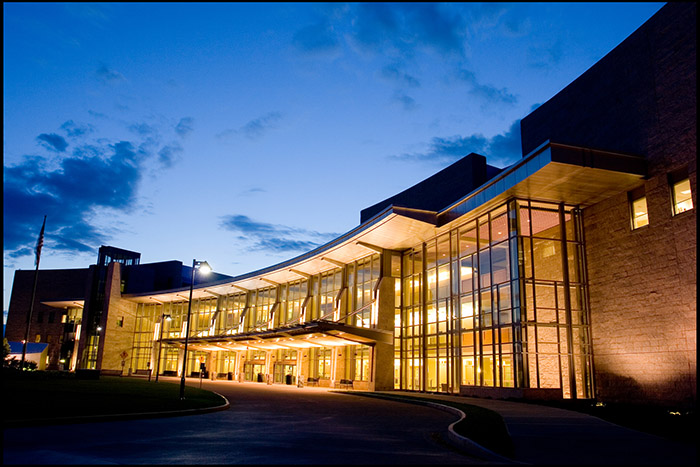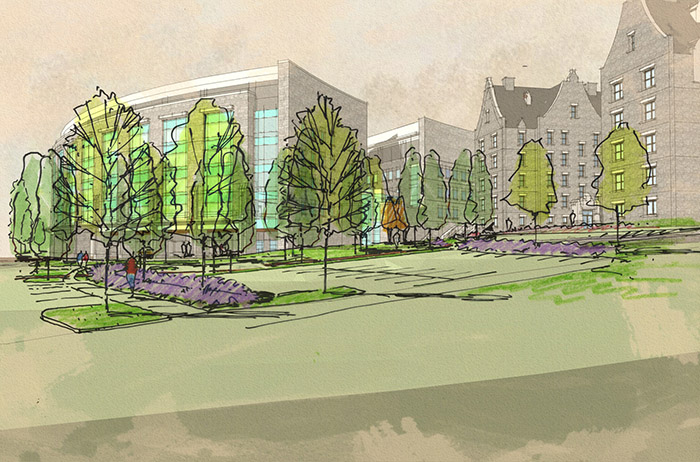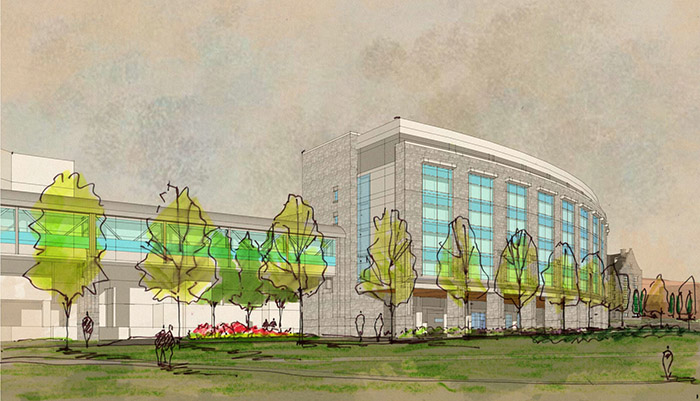| Marketing Medicine: Is UVMC’s Growth Plan Sound and Sensible? | |||||
| by Elayne Clift | |||||
The main entrance to University of Vermont Medical Center (UVMC) photo: courtesy UVM Medical Center. |
|||||
A TV ad for an online print company shows a doctor marketing his boutique medical practice using the company’s services. Ubiquitous drug advertising by the pharmaceutical industry targets patients whom, it hopes, will partner with the industry in creating demand for its pills. The New York Times runs a piece on “how advertising promotes expensive drugs and treatment you may not need” (“Ask Your Doctor if This Ad Is Right for You,” February 27, 2016) and asks whether “hospitals and drug companies are targeting the well-insured,” while pointing out that medical-related ads have become a billion-dollar industry. As mega-medical centers proliferate, consumers may reasonably ask if health care is becoming a product instead of a service. Against this backdrop, and amid growing concern about the direction and cost of health care in this country, the University of Vermont Health Network, a four-hospital partnership led by the University of Vermont Medical Center (UVMC), recently announced “a public awareness campaign” aimed at introducing its combined services and offered a “brand promise” to bring “the best of community and academic medicine together for patients” throughout Vermont and northern New York. Along with this four-hospital partnership—which includes Central Vermont Medical Center, in Berlin, and two hospitals in New York—UVMC has also developed a growth plan for its Burlington facilities. It’s an ambitious long-term plan that could cause some consumers and their advocates to wonder if medical centers generally, and UVMC specifically, are becoming “too big to fail”—or be held accountable for their expansion or expenditures.
The first planned addition to UVMC is a seven-story tower that would house private rooms, replacing existing double rooms deemed no longer useable. UVMC submitted a Certificate of Need (CON) application in September 2014 to the Green Mountain Care Board (GMCB), which maintains financial and building oversight of the project. The cost of the tower, which does not increase the number of hospital beds, was estimated to be $187 million. The GMCB has the authority to change the budget as well as to modify the CON, or demand that certain conditions be met. A hearing was held in May 2015 to consider the CON. “The board doesn’t just give an up or down vote,” says board chair Al Gobeille. “We wrestle with consumer-based care. The big question is what do patients need for the next 20 years?” With that in mind, the GMCB has imposed conditions for approval and has mandated UVMC to come back to them with specific information about financing the tower without placing cost burdens on consumers. The board is requiring that before construction can begin, UVMC must demonstrate that “stable financial footing” is in place and that debt repayment is restructured “so that the full burden of its repayment is not inherited by a future hospital administration and a new generation of health care consumers.” Updated construction costs must also be provided based upon specific construction documents rather than schematic designs. The need for the tower and private rooms is not contested. In addition to replacing its outdated double-room structure, hospitals everywhere are moving toward private rooms because research has shown that it helps reduce infection rates, decreases the likelihood of medication errors, and improves patient outcomes and patient satisfaction. Families are better able to be with the patient, and there is no need for gender matching. Dawn LeBaron, vice president for Hospital Services at UVMC, says there is a clear need for the proposed tower. “It’s not about ‘branding,’ and we are not doing this to capture market share. We have a genuine obligation to keep the facility up-to-date so that we can give patients what they deserve,” she says. “We’ve been through the most robust process I can imagine. It’s been transparent, inclusive, and aimed at cost management and efficiency.” In a posthearing memo to the GMCB after the initial CON was submitted, the Vermont Legal Aid Office of the Health Care Advocate, which has “interested party” status with the GMCB on this matter, supported the primary intent of the project (i.e., replacing semiprivate rooms with private rooms for the majority of patients) but raised concerns about the costs and affordability of the project. “It would be unacceptable for commercial rates to increase as a result of this project as predicted by [the consulting firm] Deloitte,” the letter stated. “It would [also] be unacceptable if this project were to result in decreased quality of care or increased unnecessary services. We are concerned that the new ‘efficiencies’ will include reduced staffing or other cost-cutting measures that will affect the quality of patient care.” The letter also cited the need for more psychiatric beds and improved quality of mental health units and questioned the diversity of patients involved in the planning process. It asked that more economically, racially, and culturally diverse patients and families be included in continued planning, as well as more nurses and other key staff.
The Vermont Federation of Nurses and Health Professionals, which represents almost 2,000 health-care professionals for collective bargaining purposes at UVMC, was denied interested party status on the grounds that “the CON proceeding should not be used as a forum for Union advocacy on issues related to the Project.” Mari Cordes, RN, president of the federation, said in her letter requesting the status that none of the union’s nurses or technical professional members was asked to participate in the “large cross-section of staff” invited to weigh in on proposed plans, despite the fact that “frontline health care workers—our members—are charged with the safety and well-being of patients.” She also pointed out that “the new facility [would] impact the working conditions of the nurses and other healthcare professionals.” The union was granted amicus curiae status, however, and was able to be active in the CON process, ensuring that a large number of front line workers were ultimately involved in the process. In the longer term, UVMC would like to expand out-patient facilities in South Burlington at an additional estimated cost of $52.6 million. Dr. John Brumsted, UVMC CEO, told Seven Days in a January 2015 article that the hospital network, the patient tower, and the proposed further expansion are about “gaining scale” so that the medical center can better respond to changes in health care. “It’s not about empire building,” he said, while noting that “several other organizations are on a direct pathway to become partners from both New York and Vermont.” The South Burlington plan, which involves the purchase of four commercial buildings and 100 acres in a business park near I-89 and which requires a separate CON, presents its own issues. Along with the need for a sound rationale and cost-benefit analysis, it raises concerns. Transportation is one of them. Kaili Kuiper, a staff attorney with the Office of the Health Care Advocate at Vermont Legal Aid, says she worries about bus routes, schedules, and drop-off points. “If you’re going for rehabilitation, can you reasonably be expected to walk two or three blocks to the out-patient facility?” Kuiper also echoes a larger concern shared by some health-care consumers and advocates about how big UVMC, among other medical centers, is becoming. “Smaller hospitals being bought up by larger ones is a worry,” she says. “Larger hospitals have more negotiating power, and they can increase costs.” Cordes adds her concerns. “Many community hospitals had social justice as part of their original mission in serving the sick and the poor. Now commodification of health care as a business venture makes a mission like that seem outdated. In the national move to follow the latest health-care reform dollars, we want to ensure that we keep the patient, and the people who provide direct quality care, in the center of all resource planning.”
Cordes also says she has concerns about the amount of expansion that UVMC is undertaking. “The larger the monopoly, the smaller the voice ordinary people have in how their community hospitals are run. While the process has been open to public comment, I’m not sure this is sufficiently vigorous to impact decision-making taking place by a small group of people, particularly at a time when hospital systems nationally are in the business of privatizing care, real-estate speculation, flipping property, adding to gentrification, and contributing to a painful loss of critical access hospitals in underserved areas.” In the case of UVMC’s expansion, the GMCB has put caps on expenses and is providing further sound oversight based on thorough deliberations focused on costs, quality of care, and patient needs. The Legal Aid Office of Health Care Advocate is also involved in the budget process. There is no doubt that integration of services and facilities is the wave of the future for medical centers and health-care establishments. Still, consolidation and collaboration needs to be carefully planned, monitored, and scrutinized as more people buy into well-marketed boutique care. While the chrome-and-glass appeal of new buildings can be seductive, the question remains, Is bigger better? The bottom line is: Where can all health-care consumers get the most appropriate, affordable, accessible, compassionate, and highest quality care for their particular needs at a time when “branding” grows bolder and “market share” drives the message?
|
|||||
| Elayne Clift, a specialist in communication for health promotion, writes about women, health, and social issues from Saxtons River, Vermont (www.elayne-clift.com).
|
|||||




